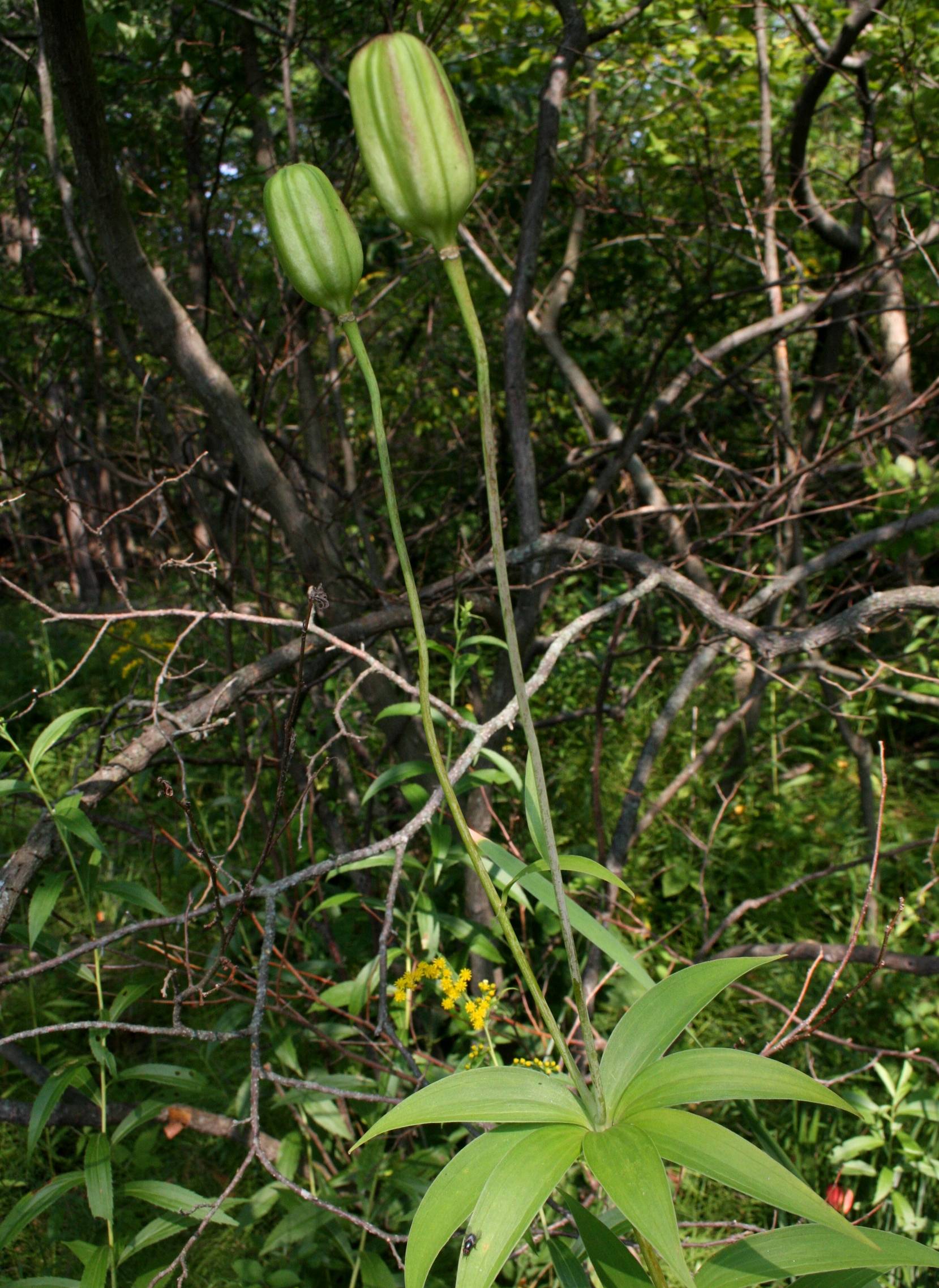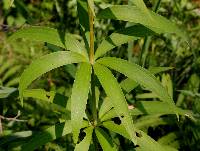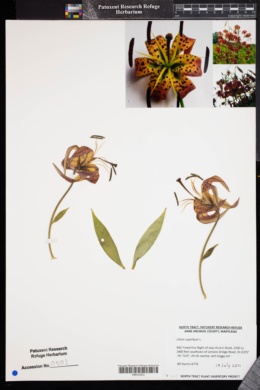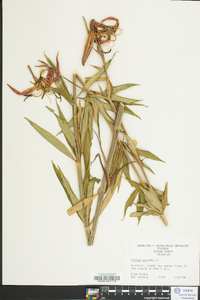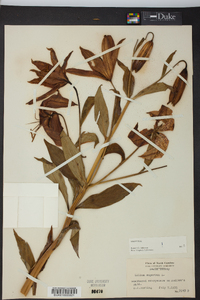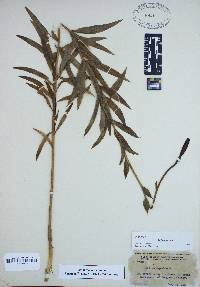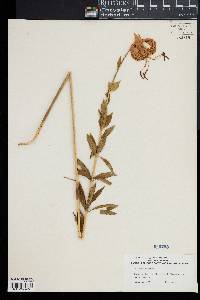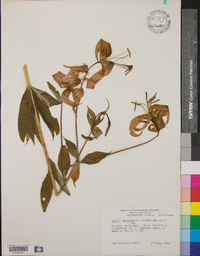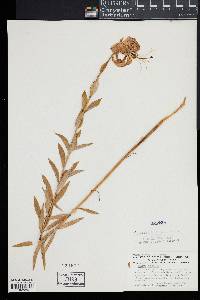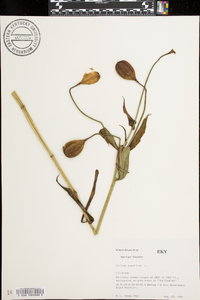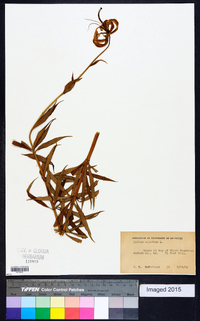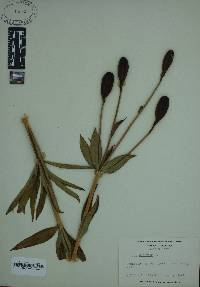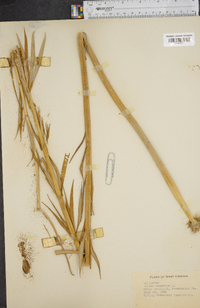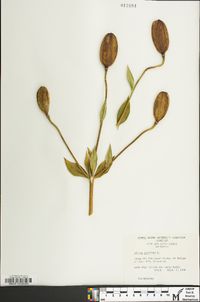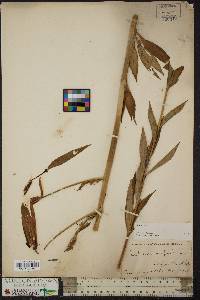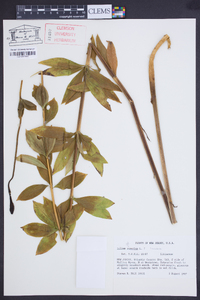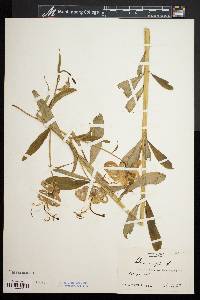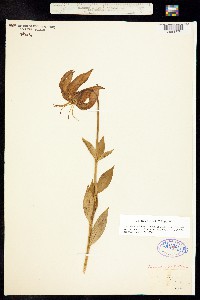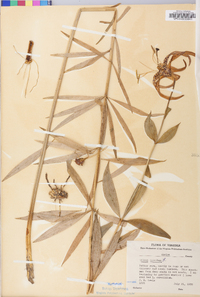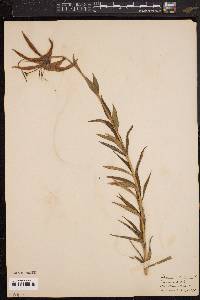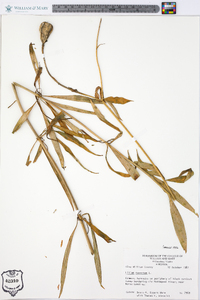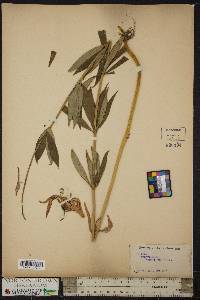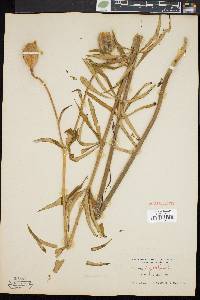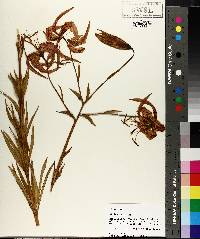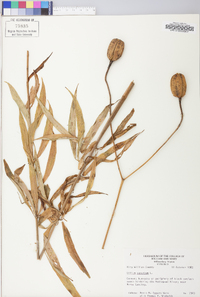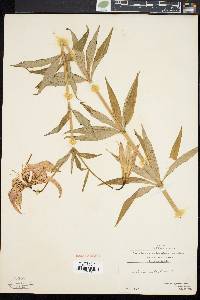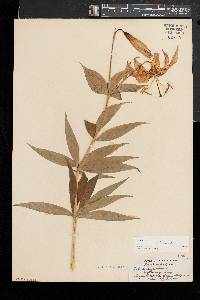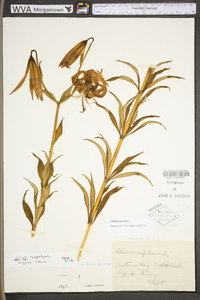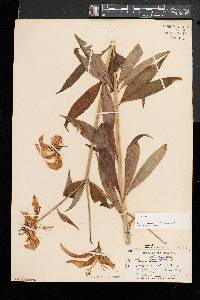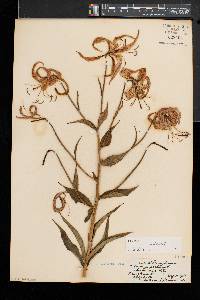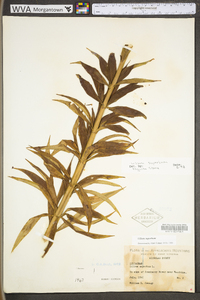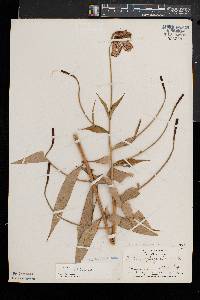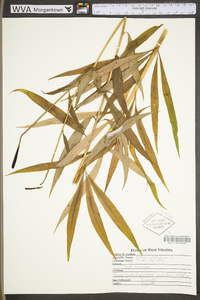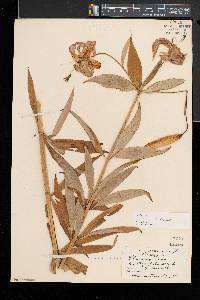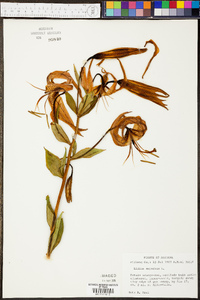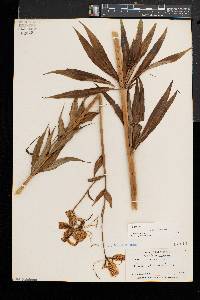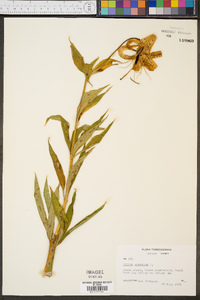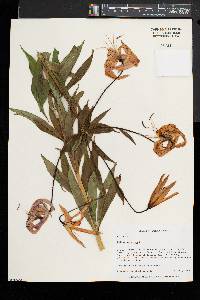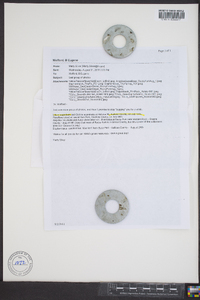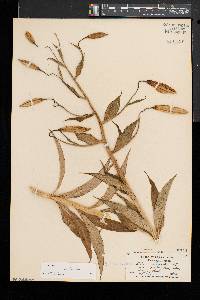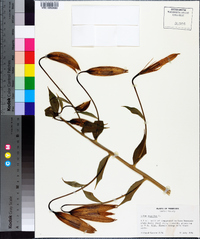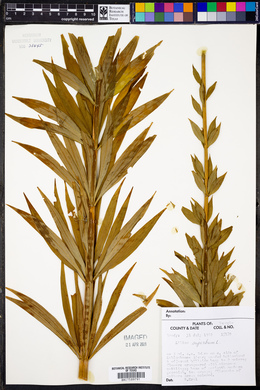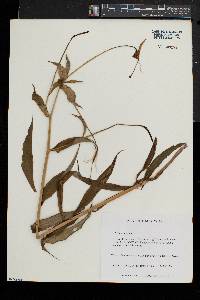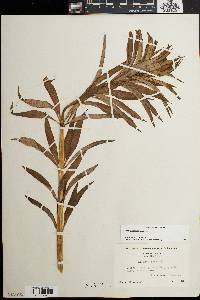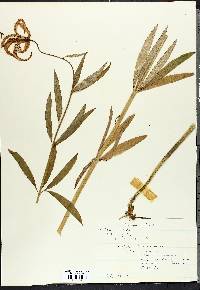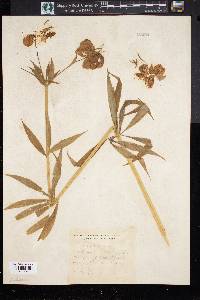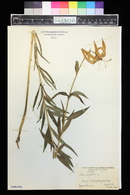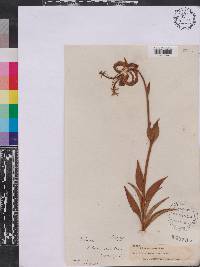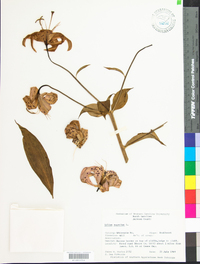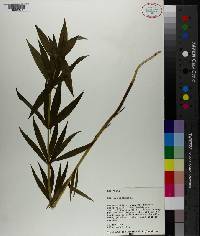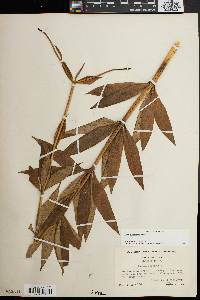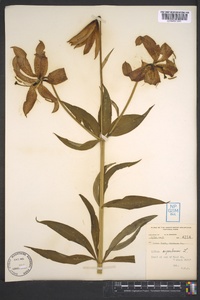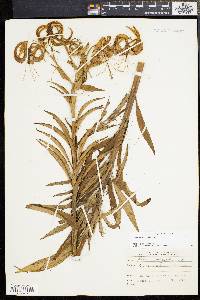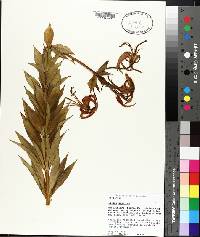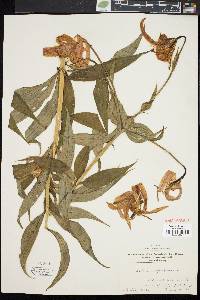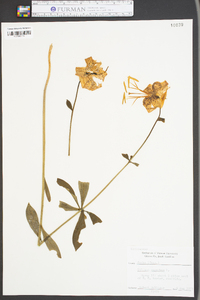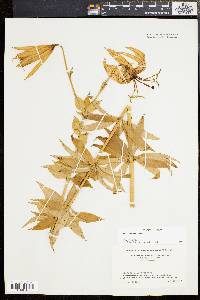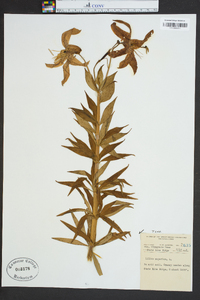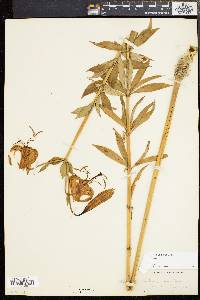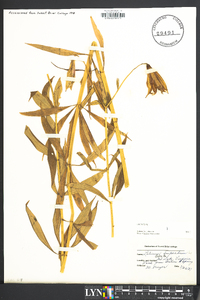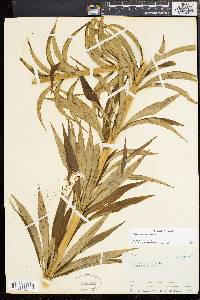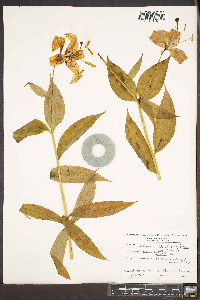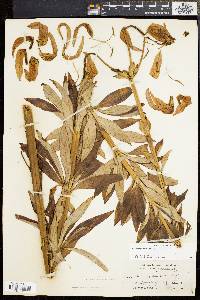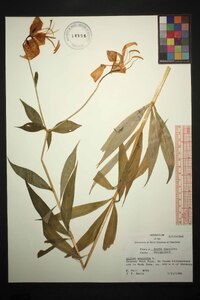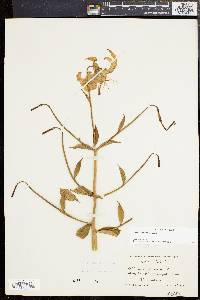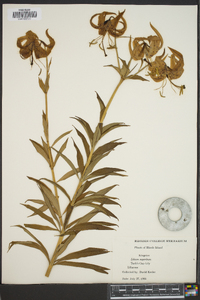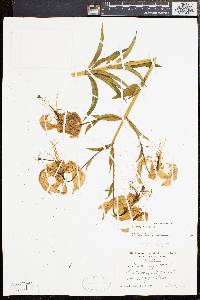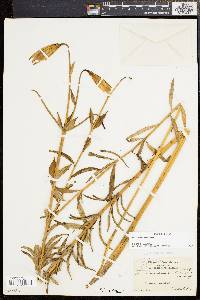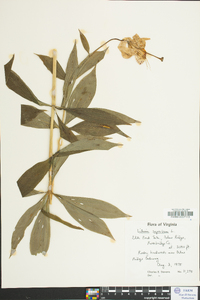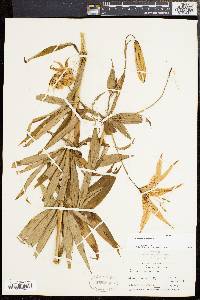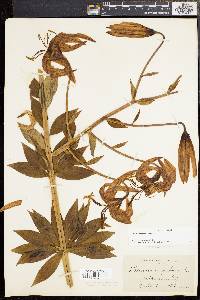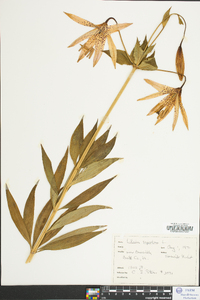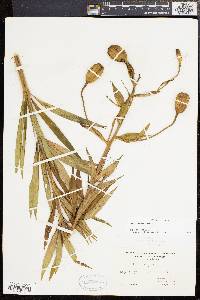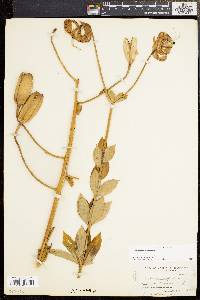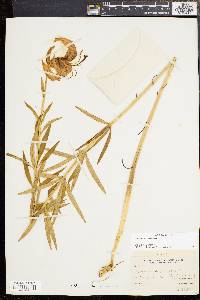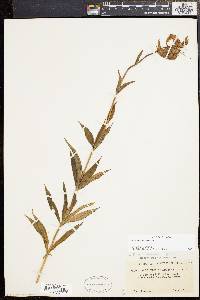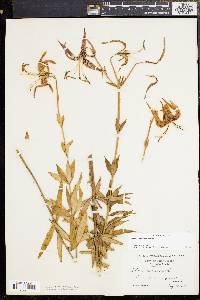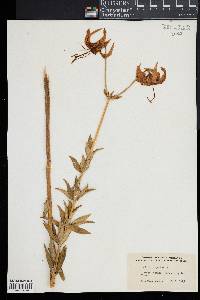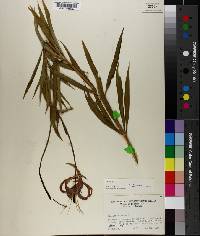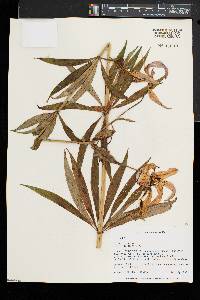
|
|
|
|
Family: Liliaceae
Turk's-Cap Lily
[Lilium canadense subsp. superum (L.) Baker] |
Bulbs rhizomatous, often branching dichotomously at 120° from main axis, 2.4-4.3 × 6-10.2 cm, 0.2-0.6 times taller than long, 2(-3) years´ growth evident as annual bulbs, the scaleless sections between these 0.6-3.8(-4.6) cm; scales 1-2-segmented (if 2-segmented, often only on inner scales), longest 1.2-3.9 cm; stem roots present or absent. Stems 1.2-2.8 m. Buds ± triangular in cross section. Leaves usually ± evenly distributed along stem, in 6-24 whorls or partial whorls, 3-20 leaves per whorl, usually ± horizontal and drooping at tips, distal leaves ascending in sun, 7.1-26.1 × 0.7-2.7 cm, 4-18 times longer than wide; blade narrowly elliptic, sometimes extremely so, occasionally barely oblanceolate, margins not undulate, apex acute, acuminate in distal leaves; veins and margins ± smooth abaxially. Inflorescences racemose, 1-22-flowered. Flowers pendent, not fragrant; perianth Turk´s-cap-shaped; sepals and petals reflexed less than 1/5 along length from base, yellow or sometimes yellow-orange proximally, red-orange or sometimes red, red-purple, orange, or yellow barely suffused with red distally, spotted magenta, not distinctly clawed, nectaries exposed, forming visible green star; sepals with 2 parallel, often faint abaxial ridges, 6.8-10.5 × 1.1-2.1 cm; petals 7-10.2 × 1.4-2.6 cm; stamens strongly exserted; filaments parallel along much or most of length, then widely spreading, diverging (7°-)11°-30° from axis; anthers magenta, occasionally purple or dull purple, 1.4-2.6 cm; pollen rust; pistil 4.7-8.2 cm; ovary 1.5-3.4 cm; style pale green, often spotted purple; pedicel 7.4-19.1 cm. Capsules 2.9-6.2 × 1.7-2.5 cm, 1.7-3.3 times longer than wide. Seeds not counted. 2n = 24. Flowering summer (Jul--early Aug). Gaps and openings in rich woods, swamp edges and bottoms, streamsides, moist meadows and thickets, balds, pine barrens, roadsides; 0--1600 m; Ala., Ark., Conn., Del., D.C., Fla., Ga., Ill., Ind., Ky., La., Md., Mass., Miss., Mo., N.H., N.J., N.Y., N.C., Ohio, Pa., R.I., S.C., Tenn., Va., W.Va. The largest Lilium east of the Rocky Mountains and the commonest over most of its range, the Turk´s-cap lily is a familiar sight throughout much of the southern Appalachians and along the northern Atlantic coastal plain. Flowers are rather variable; those in the north are sometimes floridly colored with dark purple bases on the peri-anth parts. The single report from Vermont (F. C. Seymour 1993) remains unconfirmed; however, recent collections from Washington Parish in Louisiana, Perry County in Missouri, and Bamberg County in the coastal plain of South Carolina extend the range of this species. Lilium superbum shares distinctive features with L. michauxii, L. pyrophilum, and L. iridollae that indicate a close relationship and are diagnostically useful, namely paired ridges on the backs of the sepals and buds that are triangular in cross section. None has the red style characteristic of the other eastern pendent lily clade (L. michiganense, L. canadense, and L. grayi) centered to the northwest, and only L. iridollae sometimes has the leaf margins and veins roughened abaxially as is characteristic of L. canadense and its close relatives. Common inheritance of a suite of unique, derived features and peripheral allopatric distributions suggest that Lilium pyrophilum and L. iridollae may be geographical isolates of broadly distributed L. superbum ancestral stock; both restricted species occur in specialized wetland habitats. Geography aside, the three are unequivocally distinguished only by various combinations of leaf and bulb characteristics, flower color, habitat, and blooming time. However, the overall degree of separation is comparable to that between many other species in the genus. Lilium superbum blooms the earliest, is the largest, and has the most numerous and largest flowers, and the long, narrow leaves in many whorls are distinctive. Lilium michauxii overlaps in range with these three species but is easily separated morphologically and ecologically. Lilium superbum is pollinated primarily by the swallowtail butterflies that are common within its range, among them the spicebush (Papilio troilus Linnaeus, family Papilionidae), pipevine (Battus philenor Linnaeus), and eastern tiger (Papilio glaucus Linnaeus). Great spangled fritillaries [Speyeria cybele (Fabricius), family Nymphalidae] also visit the Turk´s-cap lily (R. M. Adams and W. J. Dress 1982).
Stout and erect, to 25 dm; principal lvs whorled, the upper alternate; lf-blades lanceolate, tapering to both ends, smooth or slightly rounded-papillose along the margins; fls 1-many, nodding from long, erect or ascending pedicels; tep strongly recurved, lanceolate, 6-9 cm, orange or orange-red, spotted with purple; filaments long-exserted, outcurved distally, the anthers widely separated, mostly 15-25 mm; fl-buds 3-angled; 2n=24. Wet meadows and low ground; Mass. and se. N.H. to Ga. and Ala. July-Sept. Gleason, Henry A. & Cronquist, Arthur J. 1991. Manual of vascular plants of northeastern United States and adjacent Canada. lxxv + 910 pp. ©The New York Botanical Garden. All rights reserved. Used by permission. From Flora of Indiana (1940) by Charles C. Deam This species has been reported from various parts of the state but I think it is very rare and that most of our reports should be referred to Lilium michiganense. I have found it only three times and always on wooded slopes. This species is easily confused with Lilium michiganense if the character of the roughness or smoothness of the under surface of the leaves is the only one used. The spreading of the perianth, which begins at the base, and the length of the anthers will easily separate them, but the spreading of the perianth is a note often omitted, and herbarium specimens do not always clearly show this character. The map shows the location of the specimens that I have seen. Birkbeck passed through Indiana in 1817 and on page 112 of his "Notes on a journey in America from Virginia to the Illinois Territory" he says: "The road from Sholt's tavern to this place [from thirty-six miles east of Vincennes to Vincennes] is partly across barrens, that is, land of middling quality, thinly set with timber, or covered with long grass, and shrubby undergrowth; generally level and dry, and gaudy with marigolds, sunflowers, martagon lilies, and many other brilliant flowers." We have no way of determining the species of lily Birkbeck saw, but I think it was this species, although this is a mere guess. From Lilium michiganense this species can be distinguished by several characters in addition to those given in the key. It is about half again as high; the leaves are more numerous in at least a few of the whorls, and all the leaves are longer and conspicuously long taper-pointed at both ends; the more numerous flowers, 3-15, are in umbels or pyramidal racemes, while the flowers in the other species are strictly in umbels, generally numbering 1-5 flowers. We have had both species moved from the wild and in cultivation for many years and the greatest number of flowers of the first has been 21 while of the second I have no record; but, as I recall, the number ranges mostly from 3 to 5 in vigorous plants, and these are always in umbels. .…… Indiana Coefficient of Conservatism: C = 8 Wetland Indicator Status: FACW |
This project was made possible in part by the Institute of Museum and Library Services [MG-70-19-0057-19].
Powered by Symbiota

